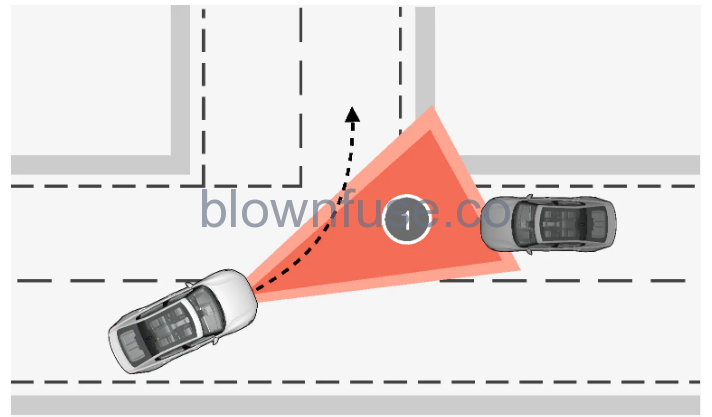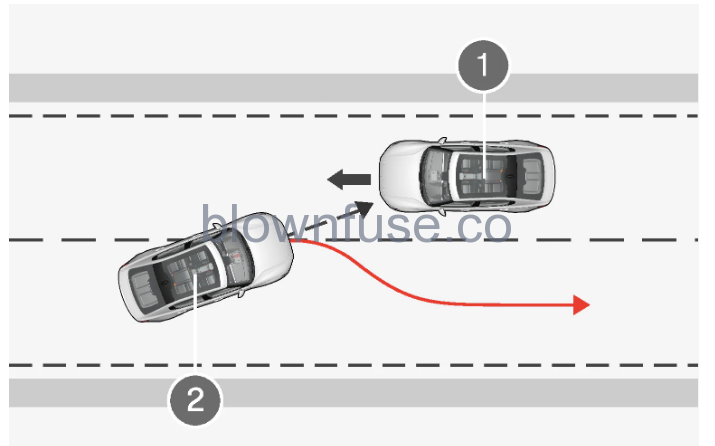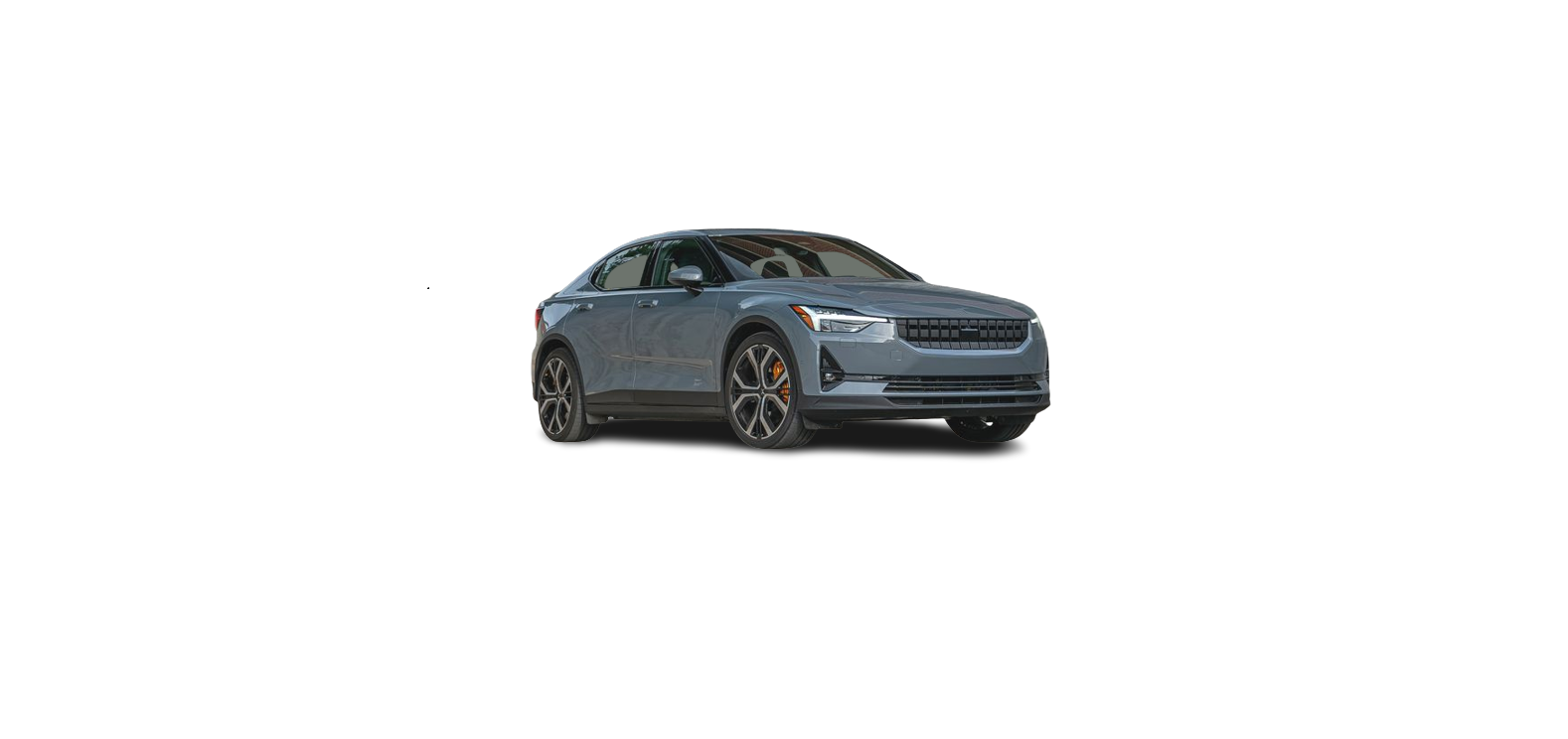 2021 Polestar 2 Assistance during collision risks
2021 Polestar 2 Assistance during collision risks
Ability to reduce speed with assistance during collision risks
Vehicles
Braking assistance can help prevent a collision with a vehicle ahead by reducing your vehicle’s speed by up to 60 km/h (37 mph).
Cyclists
Braking assistance can help prevent a collision with a cyclist by reducing your vehicle’s speed by up to 50 km/h (30 mph).
Pedestrians
Braking assistance can help prevent a collision with a pedestrian by reducing your vehicle’s speed by up to 45 km/h (28 mph).
Assistance during collision risks from behind*

The function provides assistance by steering your vehicle back into your own lane.
- Another vehicle in the blind spot zone
- Own vehicle
Even if the driver intentionally changes lanes using a turn signal without noticing another vehicle approaching, the function can provide assistance. The function is active at speeds between 60-140 km/h (37-87 mph) on roads with clearly visible traffic lane markings/lines. The lights in the door mirrors will flash while steering assistance is being provided, whether or not BLIS is activated. An audible signal will also be given.
Assistance during collision risks in crossing traffic

In order for the function to detect an oncoming vehicle in situations where there is a risk of a collision, that vehicle must be within the sector in which the function can analyze the situation.
The following conditions must also be met:
- your vehicle’s speed must be at least 4 km/h (3 mph).
- your vehicle must be making a left turn.
- The oncoming vehicle’s headlights must be on.
The function may be unable to assist the driver if, for example:
- the road is slippery and Electronic Stability Control (ESC) is intervening.
- the oncoming vehicle is detected at a late stage.
- the oncoming vehicle is partially obstructed by another vehicle or object.
- the oncoming vehicle’s headlights are off.
- the oncoming vehicle is moving erratically and e.g. suddenly changes lanes at a late stage.
The function uses the vehicle’s camera and/or radar units, which have certain general limitations.
Assistance during collision risks in oncoming traffic
When the vehicle veers into oncoming traffic
This function can help a distracted driver who has not noticed that the vehicle is about to veer into a traffic lane moving in the opposite direction.
The function provides assistance by swerving your vehicle back into your own lane.
- Oncoming vehicles
- Own vehicle
The function is active at speeds between 60-140 km/h (37-87 mph) on roads with clearly visible traffic lane markings/lines.
If your vehicle is starting to veer from your own lane and a vehicle is approaching from the opposite direction, this function can help the driver steer the vehicle back into its own lane. However, the function will not provide steering assistance if the turn signal is used. The function will also not be activated if it detects that the driver is actively operating the vehicle.
Warnings and brake interventions due to an imminent collision with an oncoming vehicle always come very late.
The function uses the vehicle’s camera and/or radar units, which have certain general limitations.
Assistance during collision risks limitations
Braking assistance limitations
Slippery road conditions
The extended braking distance on slippery roads may reduce the function’s capacity to help avoid a collision. In these types of situations, the Anti-lock Braking System and Electronic Stability Control (ESC ) are designed for optimal braking power with maintained stability.
Low speed
The function is not activated at very low speeds under 4 km/h (3 mph). The system will therefore not intervene in situations in which your vehicle is approaching another vehicle very slowly, such as when parking.
Active driver
The driver’s commands are always prioritized. In situations in which the driver is clearly steering and applying the accelerator pedal, the function will not intervene, even if a collision is unavoidable. An active and aware driving style may therefore delay collision warnings and intervention in order to minimize unnecessary warnings.
Steering assistance limitations
The function may have limited functionality in certain situations and not intervene, e.g.:
- for smaller vehicles such as motorcycles
- if more than half of your vehicle has moved into the adjacent lane
- on roads/lanes with indistinct or no side lane markings
- outside the speed range 60-140 km/h (37-87 mph)
- when speed-dependent power steering wheel resistance is working at reduced power – e.g. during cooling due to overheating.
Functionality may also be reduced in other situations, such as:
- road work
- winter driving conditions
- narrow roads
- poor road surfaces
- a very sporty driving style
- bad weather with reduced visibility.
In these demanding driving conditions, the function may not be able to properly assist the driver.
Important warnings
The driver support system only issues a warning for obstacles detected by its camera and radar units, which means that warnings may come after a delay or not at all.
- Never wait for a warning or assistance. Apply the brakes when necessary.
- Auto-braking can prevent a collision or reduce collision speed, but to ensure full brake performance the driver should always depress the brake pedal – even when the vehicle brakes automatically.
- The warning and steering assistance are only activated if there is a high risk of collision – you must therefore never wait for the collision warning or the function to intervene.
- The function does not activate automatic braking intervention during heavy acceleration.
- Warnings and brake interventions can be triggered late or not at all if the traffic situation or external influences prevent the camera and radar sensor from properly detecting pedestrians, cyclists or vehicles ahead of the vehicle.
- To be able to detect vehicles at night, its front and rear lights must work and illuminate clearly.
- Warnings for stationary or slow-moving vehicles may be disabled due to darkness or poor visibility.
- Warnings and brake interventions for pedestrians and cyclists are disengaged at vehicle speeds over 80 km/h (50 mph).
- The system can provide effective warnings and brake intervention if the relative speed is lower than 50 km/h (30 mph).
- For stationary or slow-moving vehicles, warnings and brake interventions are effective at vehicle speeds of up to 70 km/h (43 mph).
The function uses the vehicle’s camera and/or radar units, which have certain general limitations.
Only a workshop may perform maintenance on driver support components – contact Polestar Customer Support.

